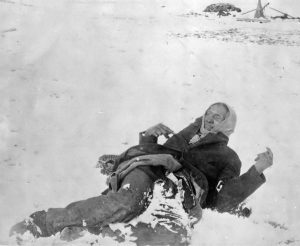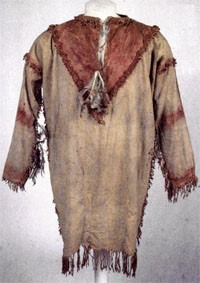The Lakota were in desperate need of hope at the end of the 1800s; food and land were becoming increasingly scarce. A Paiute holy man named Wovoka had a vision in which the buffalo returned and the whites disappeared, leaving the Sioux free to live peacefully as they once had. The way that this world would come about, he said, was by the return to traditional ways and the practice of the Ghost Dance.
The U.S. government saw the Ghost Dance as a threat to their underlying goals of assimilation and extermination because of the unison that it represented among the Sioux. This led to the sending of troops to the Pine Ridge Reservation in South Dakota and the eventual occurrence of what is now known as the Wounded Knee Massacre, but what was once referred to as a battle by the U.S. It began with a gunshot of unknown origin that led the soldiers to commence firing on the encampment and resulted in the death of at least 150 Native men, women, and children and about 30 soldiers.

After the killing was done, Ghost Dance shirts, as well as other possessions, were stolen off the bodies and sold to museums and collectors. The repatriation of these stolen objects has been advocated for by the Wounded Knee Survivors Association who have had some success. Among the items that have been repatriated were locks of hair supposedly from Chief Big Foot that were at a library in Barre, Massachusetts and a Ghost Dance shirt that was given to the Kelingrove Art Gallery and Museum in Glasgow, Scotland by a member of Buffalo Bill’s Wild West show in 1892. The shirt, which has enormous cultural significance because it was believed to have protective powers and was implemented in the Ghost Dance religion, returned home in 1999 after over a century of being overseas. Regarding its return, Marcella LeBeau of the Two Kettle Band/Cheyenne River Sioux said, “This will bring about a sense of closure to a sad and horrible event. Now healing can begin.”

Further reading on the:
Massacre:
http://www.history.com/topics/native-american-history/wounded-knee
Ghost shirt:
http://articles.latimes.com/1999/aug/08/local/me-63757
Ghost Dance:
http://www.colorado.edu/csilw/arapahoproject/dance/Ghostdance/history.html
http://www.ndstudies.org/resources/IndianStudies/standingrock/historical_ghostdance.html

There wasn’t a truth and reconciliation process… that is part of the problem. It just keeps getting buried again and forgotten about.
It’s great to see what kind of closure repatriation can bring to ancestors of survivors of events like the Wounded Knee Massacre. This is a good example of a foreign museum participating in repatriation of artefacts to overseas indigenous peoples. However, it is unfortunate that many institutions are unwilling to participate in this type of process, as we have seen with the Paris auction house which was unwilling to work with indigenous Americans to repatriate stolen artefacts, just because they could not prove they were stolen. It is especially shocking to me that this participation is not happening in the light of the United Nations Declaration on the Rights of Indigenous Peoples stating repatriation as a right for indigenous peoples and an obligation of states.